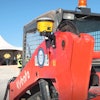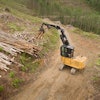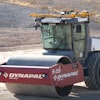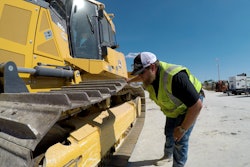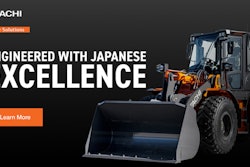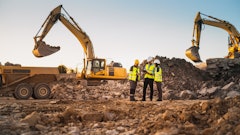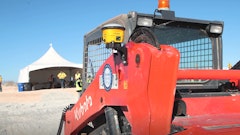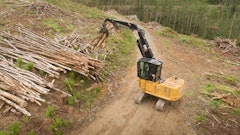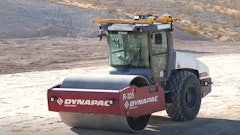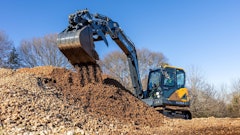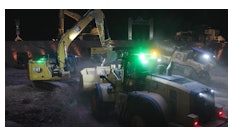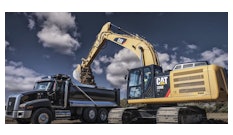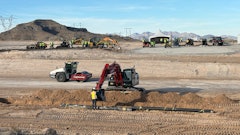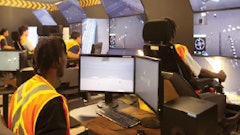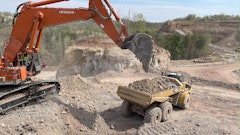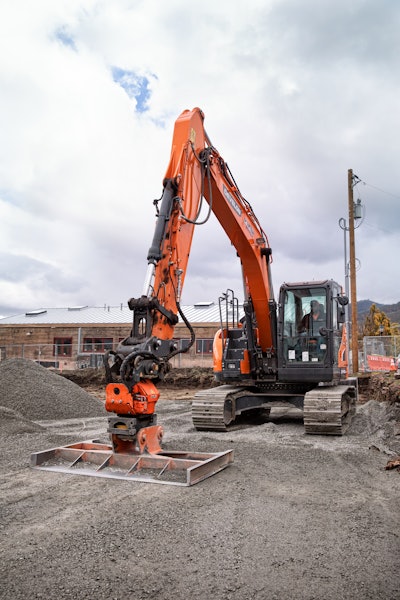
Technological advancements have revolutionized excavators, elevating them from basic digging machines to versatile tools that redefine efficiency, productivity, and safety at jobsites.
From designing modern electrohydraulic control systems to adding advanced object detection technologies, excavator manufacturers are constantly pushing the boundaries of what these machines can accomplish. Consequently, these versatile machines have become indispensable. Here are some of the latest excavator innovations tailored for the construction industry.
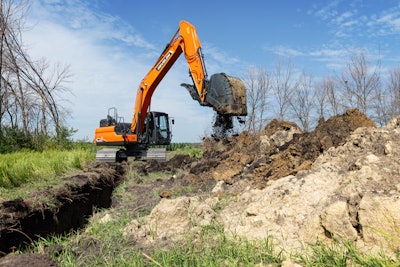 The 2D system allows operators to work off a single plane, such as a straight-line trench, from point A to point B.DEVELON North America
The 2D system allows operators to work off a single plane, such as a straight-line trench, from point A to point B.DEVELON North America
Electrohydraulic Control System
An electrohydraulic control system has increased precision, safety, and efficiency in construction and earthmoving operations. The sophisticated system uses both electrical and hydraulic components to manage the excavator’s movements and functions. It integrates electronic sensors, controllers, and actuators with traditional hydraulic components, providing more precise and efficient control over the excavator’s operations.
An electrohydraulic control system in an excavator can include the following features:
- Programmable joystick switches that provide ease of operation.
- Fully electronic joystick to manage various functions of the excavator.
- Swinging sensor that measures and monitors the swinging motion of the excavator's upper structure.
- Equipment sensors on the boom, arm, bucket, and upper body, including a laser catcher, to assist with the 2D grading system.
Grade Assist
Grade assist systems for excavators are used to achieve precise and accurate surface grading or leveling. They ensure that the desired slope, elevation, and contour of the terrain are achieved. When excavator operators activate the grading system, a touchscreen setting enables them to set the assist mode — allowing the computer to assist the operator through audio and visual displays. The operator controls the arm function and the machine automatically manages the bucket and boom to maintain the desired grade or slope. The touchscreen monitor can give operators better control over the direction of travel, as well as more precision when setting the bucket-tooth depth, height, and slope in earthmoving and grading applications.
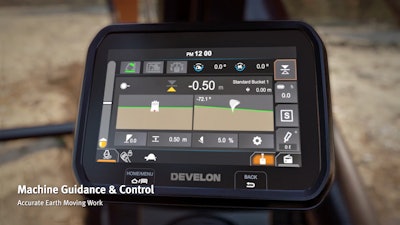 Grade assist systems for excavators are used to achieve precise and accurate surface grading or leveling.DEVELON North America
Grade assist systems for excavators are used to achieve precise and accurate surface grading or leveling.DEVELON North America
2D Grading System
Along with other advanced machine guidance and machine control systems, the 2D grading system is a valuable technology. The 2D system allows operators to work off a single plane, such as a straight-line trench, from point A to point B.
By utilizing sensors and controllers, the 2D grading system can make real-time adjustments to achieve the precise slope and elevation required for the job. This eliminates the manual labor involved in traditional grading methods and improves productivity by streamlining the grading process and reducing the time and effort required to complete grading tasks.
 The fine swing function controls the rotational movement of the excavator’s upper structure, known as the swing motion.DEVELON North America
The fine swing function controls the rotational movement of the excavator’s upper structure, known as the swing motion.DEVELON North America
Fine Swing Function
The fine swing function controls the rotational movement of the excavator’s upper structure, known as the swing motion. Activating the fine swing function gives operators greater control when lifting an object and enhances accuracy when placing it. Additionally, it increases operator safety in certain lifting applications, like pipe laying, and can prevent damage caused by the object falling from the excavator.
This function can be manually turned on or off by the operators, giving them control over whether the feature is active or not. When the function is activated, the “overrun” disappears, allowing the excavator to smoothly reach maximum swing speed while removing any sudden jerks or shocks from the turn. Operators can turn off the rotation or slew, and brake to prevent material loss from the bucket.
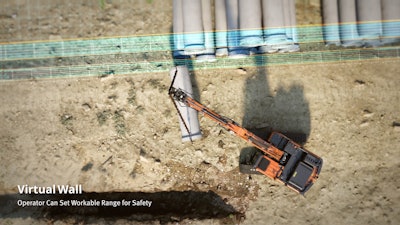 Precision technology features, such as a virtual wall setting, help operators enhance safety and productivity when working in confined spaces.DEVELON North America
Precision technology features, such as a virtual wall setting, help operators enhance safety and productivity when working in confined spaces.DEVELON North America
Virtual Wall Setting
Precision technology features, such as a virtual wall setting, help operators enhance safety and productivity when working in confined spaces. The excavator is equipped with GPS receivers or proximity sensors that monitor the machine’s position relative to predefined coordinates or objects on the jobsite. For instance, if there are obstacles on one or both sides of the machine, the operator can set limits to prevent the machine from swinging past them. They can also adjust the settings for arm extension and set upper and lower limits. If the excavator gets too close to either side, where the obstacles are located, the system alerts the operator and restricts the machine’s movement in the direction of the obstacle. The function can be overridden at any time.
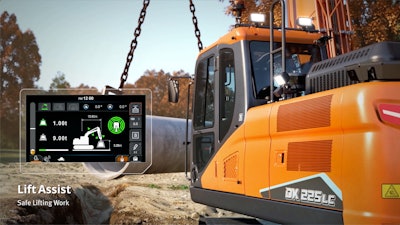 Excavators regularly lift or crane objects on job sites, so with lift assist, operators can remove the guesswork from the process.DEVELON North America
Excavators regularly lift or crane objects on job sites, so with lift assist, operators can remove the guesswork from the process.DEVELON North America
Lift Assist Mode
Excavators regularly lift or crane objects on jobsites, so with lift assist, operators can remove the guesswork from the process. This function measures and displays the current weight of the bucket as materials are being loaded, as well as the tipping load, and alerts the operator when the total loading weight is exceeded. The sensors are accurate to within 3%. This function can alleviate concerns about tipping the machine if the object is too heavy (e.g., large rocks, concrete blocks, and heavy machinery components).
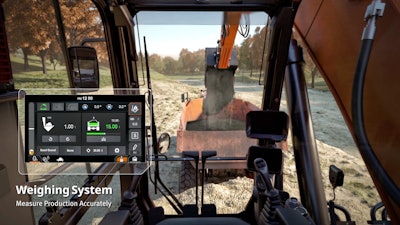 An onboard weighing system uses load cells and sensors to measure the weight of the material and provide real-time feedback to the operator to optimize the loading process.DEVELON North America
An onboard weighing system uses load cells and sensors to measure the weight of the material and provide real-time feedback to the operator to optimize the loading process.DEVELON North America
Onboard Weighing System
An onboard weighing system uses load cells and sensors to measure the weight of the material and provide real-time feedback to the operator to optimize the loading process. It can accurately measure the amount of material loaded into the machine as well as reduce the trips required to move the necessary material. In addition, an onboard weighing system can help minimize fuel consumption and wear on equipment. It helps companies comply with weight restrictions and prevents overloading, which can result in fines and damage to the machine. It also contributes to a safer work environment for operators and other personnel working in proximity to the equipment.
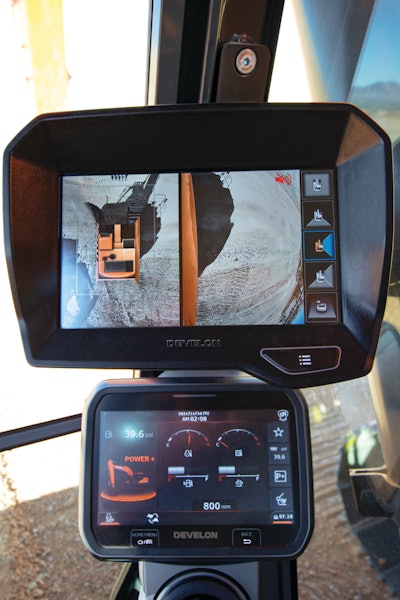 Depending on the machine, AVM systems can offer up to 360 degrees of visibility through the monitor inside the machine’s cab.DEVELON North America
Depending on the machine, AVM systems can offer up to 360 degrees of visibility through the monitor inside the machine’s cab.DEVELON North America
Around View Monitor Camera Systems
Around view monitor (AVM) camera systems display a full view of the machine’s surroundings, providing operators greater confidence when working in tight conditions. Depending on the machine, AVM systems can offer up to 360 degrees of visibility through the monitor inside the machine’s cab. This enables operators to identify potential hazards and obstacles that may not be visible from their seats, reducing the risk of accidents and injuries. AVM systems also enhance productivity and efficiency by minimizing the time required for operators to look around and check their surroundings manually.
Another key feature becoming standard on many of today’s excavators is a rearview camera. With a rearview camera, operators can more safely maneuver around any object or person within the camera’s line of sight. The camera view can be seen on the LCD monitor in the cab by simply pressing a button to activate the feature. Some manufacturers have increased the camera’s field of view or have included sensors to alert the operator when they are about to hit something - also known as object detection. Object detection improves safety by enhancing awareness and compensating for blind spots in challenging applications. The sensors emit a sound to alert machine operators when they are about to bump into an object. The sound may get louder or more frequent the closer the machine gets to the object.
Excavator technologies have become smarter, more efficient, and more productive than ever before, pushing the boundaries of the way construction projects are executed and shaping the future of the industry.

